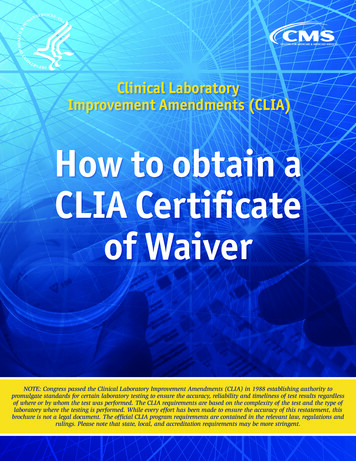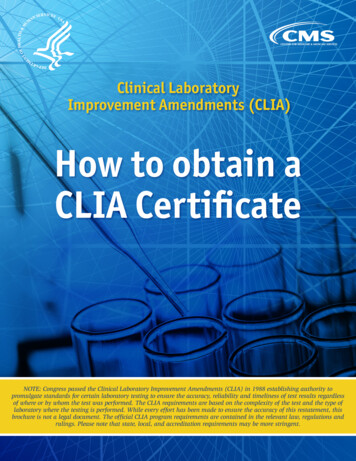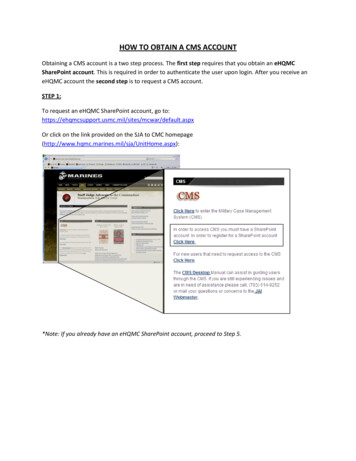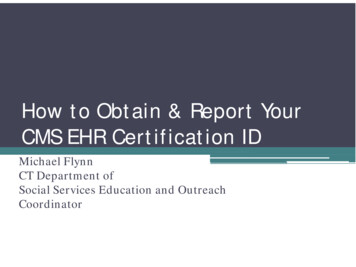
Transcription
Clinical LaboratoryImprovement Amendments (CLIA)How to obtain aCLIA Certificateof WaiverNOTE: Congress passed the Clinical Laboratory Improvement Amendments (CLIA) in 1988 establishing authority topromulgate standards for certain laboratory testing to ensure the accuracy, reliability and timeliness of test results regardlessof where or by whom the test was performed. The CLIA requirements are based on the complexity of the test and the type oflaboratory where the testing is performed. While every effort has been made to ensure the accuracy of this restatement, thisbrochure is not a legal document. The official CLIA program requirements are contained in the relevant law, regulations andrulings. Please note that state, local, and accreditation requirements may be more stringent.
What is a laboratory?Under CLIA, a laboratory is defined as a facility that performsapplicable testing on materials derived from the human bodyfor the purpose of providing information for the diagnosis,prevention, or treatment of any disease or impairment of, orassessment of the health of, human beings.I am a physician performing urine dip sticks and fingersticks for blood glucose in my office as part of the patient’svisit. Am I considered to have a laboratory and do I need aCLIA certificate?Generally yes, as those tests likely qualify as waived laboratorytesting, you need a CLIA Certificate of Waiver and you must follow the manufacturer’sinstructions. This kind of testing requires a CLIA certificate regardless of how many testsyou perform, even if you do not charge the patient or bill Medicare or other insurances.However, you may not need a CLIA certificate if your laboratory is located in the statesof New York or Washington, as those States operate their own laboratory regulatoryprograms. Contact the appropriate State Agency to determine if you need a CLIAcertificate.What is a waived test?As defined by CLIA, waived tests are categorized as “simple laboratory examinationsand procedures that have an insignificant risk of an erroneous result.” The Food andDrug Administration (FDA) determines which tests meet these criteria when it reviewsmanufacturer’s applications for test system waiver.Where can I find a list of waived tests?For a list of waived tests sorted by analyte name, visit the FDA website at:CLIA – Currently Waived AnalytesCan I perform tests other than waived tests if I have a Certificate of Waiver?No, only those tests that are CLIA-waived can be performed by a laboratory with aCertificate of Waiver.2
How do I enroll in or apply to the CLIA program?You can enroll your laboratory in the CLIA program by completing an application (FormCMS-116) available on the CMS CLIA website or from your local State Agency. Send yourcompleted application to the address of the local State Agency for the State in whichyour laboratory is located. Additionally, check with your State Agency for any otherstate-specific requirements. If you do not have online access and do not have informationabout your State Agency, you may contact the CLIA program at 410-786-3531 for theaddress and phone number of your State Agency.If I have more than one office and perform waived testing at more thanone site, do I need additional certificatesYou will need a CLIA certificate for each site where you perform testing, unless youqualify for one of the exceptions listed below: If your testing location changes, such as with mobile units providing laboratorytesting, health screening fairs, or other temporary testing locations, the testing maybe covered under the certificate of the designated primary site or home base, using itsaddress. If you are performing limited public health testing, you may file a single applicationto cover multiple locations. Limited public health testing is defined as not-for-profit orFederal, State or local government laboratories that engage in limited testing (not morethan a combination of 15 moderately complex* or waived tests per certificate). So youmay be able to cover the waived testing you perform at more than one office if youmeet this exception. If your testing locations are within a hospital and are located at contiguous buildingson the same campus and under common direction, you may file a single applicationfor the laboratory sites within the same physical location or street address.Contact your State Agency if you have questions or you are filing a single application formore than one testing site.*Laboratory tests regulated under CLIA are categorized by the FDA as either waived, moderate complexityor high complexity based on set criteria.3
Will I receive an identifying CLIA number?You will receive a ten-character alpha-numeric code on the CLIA certificate. This numberwill be utilized to identify and track your laboratory throughout its entire history. Youshould use this number when making inquiries to the State Agency and CMS about yourlaboratory.When can I start performing the waived testing?After you apply for your certificate, you will receive a fee coupon assessing a fee. Followthe instructions on the fee coupon for payment. After your payment is received, yourcertificate will be mailed to you. You generally may begin testing once you have receivedyour CLIA certificate, but you also need to check with your State Agency, since somestates have additional state-law requirements.If I only perform waived tests, what does CLIA require that I do?For waived testing, CLIA requires that you: Enroll in the CLIA program by obtaining a certificate; Pay the certificate fee every two years; Follow the manufacturer’s instructions for the waived tests you are performing; and Notify your State Agency of any changes in ownership, name, address or LaboratoryDirector within 30 days, or if you wish to add tests that are more complex.How and when will I be inspected?Laboratories with a Certificate of Waiver are not subject to a routine inspection (survey)under the CLIA Program, but may be surveyed in response to a complaint or if they areperforming testing that is not waived.4
What does it mean to follow the manufacturer’s instructions for performingthe test?To follow the manufacturer’s instructions for performing the test means to follow allof the instructions in the package insert from “intended use” to “limitations of theprocedure.” The manufacturer’s instructions can be found in the package insert for eachtest. It is good laboratory practice and important to read the entire package insert beforeyou begin testing. Be sure the package insert is current for the test system in use, thecorrect specimen type is used, the proper reagents (testing solutions) are added in thecorrect order, and the test is performed according to the step by step procedure outlinedin the package insert.Some waived tests also have quick reference instructions included, which are cards orsmall signs containing diagrams or flow charts with essential steps for conducting thetest. Be sure that quick reference instructions are current for the test system in use andare available to the individuals performing the test.How do I know if I have current manufacturer’s instructions?Always use the package insert or quick reference instructions that come with the testsystem you just opened. If you are unsure whether you have current instructions, contactthe manufacturer at the telephone number listed in the package insert.Why is it important to follow the current manufacturer’s instructions?It is important to always follow the current test system’s instructions precisely to besure your results are accurate. This includes performing any quality control proceduresthat the manufacturer recommends or requires. Over time, a manufacturer may makemodifications to a test system that result in changes to theinstructions. Failure to use the current instructions could causeinaccurate results that may result in a misdiagnosis or delay inproper treatment of a patient.5
Do I need to follow all the manufacturer’s instructions on how to performthe test?Yes, all the information in the test package insert instructions is considered part ofthe manufacturer’s instructions and must be followed. Some examples of thisinformation are: Observing storage and handling requirements for the test system components; Adhering to the expiration date of the test system and reagents, as applicable; Performing quality control, as required by the manufacturer; Performing function checks and maintenance of equipment; Training testing personnel in the performance of the test, if required by themanufacturer; Reporting patients’ test results in the units described in the package insert; Sending specimens for confirmatory tests, when required by the manufacturer; and Ensuring that any test system limitations are observed.Can I follow the quick reference guide instead of following the package insert?No, the quick reference guide is only a synopsis of the entire package insert.When performing waived testing, am I required to do everything in theinstructions, even if some of the items are manufacturer’s recommendations orsuggestions?Yes, you must follow all instructions when such terms as “always,” “require,” “shall,”and/or “must” are used by the manufacturer.You have the option to follow the recommendations or suggestions of the manufacturer.However, adhering to the manufacturer’s recommendations and suggestions will helpensure the accuracy and reliability of the test, and is considered good laboratory practice.6
As a laboratory director, what kinds of things can I do to help ensure the accuracyand reliability of the waived testing in my laboratory?In order to ensure the accuracy and reliability of waived testing in your laboratory, youshould develop and maintain good laboratory practices. Some examples are listed below: Provide specific training to the testing personnel so that you are certain they: Collect specimens appropriately; Label and store specimens appropriately; Understand and then follow the manufacturer’s instructions for each testperformed; Know how to perform the testing; Know how to document and communicate the test results; and Are able to identify inaccurate results or test system failures.Observe and evaluate your testing personnel to make certain the testing is accurate. Do they positively identify the patient and specimen? Do they collect a proper specimen? Do they know how the specimen should be preserved, if applicable? If the specimen needs to be transported, do your testing personnel understand andadhere to the transport requirements? Check for extreme changes in such things as humidity, temperature, or lighting; asthese may affect test results. Make sure that the patient specimen is handled properly from collection to testcompletion.Where can I find more information about good laboratory practices?The Centers for Disease Control and Prevention has published recommendations for“Good Laboratory Practices for Waived Testing Sites” in Morbidity and Mortality WeeklyReports (MMWR); Recommendations and Reports. The MMWR publication providescomprehensive recommendations for facilities that are considering introducing waivedtesting or offering a new waived test, and good laboratory practices to be followedbefore, during, and after testing. You can find this article on the CDC CLIA WaivedTesting website.Additionally, there are free educational materials on waived testing on the CDC Divisionof Laboratory Systems website.7
Can I make any changes to the test system instructions?No, it is not acceptable for you to make changes to the current instructions providedwith the test system. This could change the “intended use” of the test system asapproved by FDA and result in a test that is no longer waived. For example, if a testspecifies urine as the waived specimen type and you test a different body fluid, then youare no longer performing a waived test and your laboratory is subject to an inspectionand additional CLIA requirements. You must be sure that testing personnel follow thedirections exactly, and add the proper reagents in the correct order and amount given bythe manufacturer to ensure correct test results.Where can I get additional information?For additional information, you can email questions to the CMS Lab Excellence mailboxat: LabExcellence@cms.hhs.gov.CLIA Law & RegulationsCDC CLIA websiteFDA CLIA website8
Hyperlink TableEmbedded HyperlinkComplete URLCLIA – Currently Waived h/cfdocs/cfClia/analyteswaived.cfmForm Forms/Downloads/CMS116.pdfCMS CLIA e/Legislation/CLIA/index.html?redirect /CLIA/State /Legislation/CLIA/Downloads/CLIASA.pdf“Good Laboratory Practices forWaived Testing CDC CLIA Waived Testing ests/default.aspxCDC Division of LaboratorySystems aterials.htmlCLIA Law and fault.aspxCDC CLIA websitehttps://wwwn.cdc.gov/clia/default.aspxFDA CLIA 105.htmMarch 20199
If you are performing limited public health testing, you may file a single application to cover multiple locations. Limited public health testing is defined as not-for-profit or Federal, State or local government laboratories that engage in limited testing (not more than a combination of 15 moderately complex * or waived tests per certificate .











